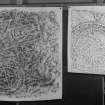Hillhead Of Clatt, Salmon Stone
Pictish Symbol Stone (Pictish)
Site Name Hillhead Of Clatt, Salmon Stone
Classification Pictish Symbol Stone (Pictish)
Alternative Name(s) Percylieu Stone; Leith Hall
Canmore ID 17656
Site Number NJ52NW 19
NGR NJ 5399 2998
Datum OSGB36 - NGR
Permalink http://canmore.org.uk/site/17656
- Council Aberdeenshire
- Parish Kennethmont
- Former Region Grampian
- Former District Gordon
- Former County Aberdeenshire
Clatt 4, Hillhead of Clatt (Percylieu Stone), Aberdeenshire, Pictish symbol stone
Measurements: H 1.22m, W 0.61m
Stone type: whinstone
Place of discovery: NJ c 532 263
Present location: in the walled garden at Leith Hall (NJ 5399 2998).
Evidence for discovery: recorded in 1842 a few years after it was discovered. It was dug up from a depth of ‘about six feet’ near some cairns on the farm of Hillhead of Clatt, and re-used as a sill stone at Percylieu mill. It remained at Percylieu until the 1890s, when it was taken to Cransmill Farm. At some later date it was taken to Leith Hall.
Present condition: the slab was trimmed into a rectangle when it was re-used at the mill, and consequently most of the salmon and the left-hand edge of the arch are missing.
Description
This slab bears parts of two incised symbols: a salmon above an arch.
Date: seventh century.
References: New Statistical Account 12, 851-2; Stuart 1856, pl 5; ECMS pt 3, 181-2; Fraser 2008, no 41.
Compiled by A Ritchie 2017
NJ52NW 19 5399 2998.
(NJ 541 297) The fragment of a Pictish symbol stone, known as the Percylieu Stone from one of its intermediary sites (NJ 5354 2646) is now at Leith Hall. It is a rectangular slab of whinstone, 3 feet by 18 inches, and bears at the top, the two fins of a fish, the rest of which is broken away, and below it the horse-shoe symbol which is ornamented with lines and dots. The NSA (1845) records that the whole stone, 4 feet long by 2 feet broad had recently been dug up, from a depth of about 6 feet, and implies that it was found in the vicinity of the cairns north of Newbigging (NJ52NW 11 and NJ52NW 18 ).
Gurnell (1884) adds that it stood at a well called the 'Salmon Well' at Hillhead (NJ 521 265) until about 1844 when it was removed to Percylieu, where it was broken to fit a door sill. About 1887 it was taken to Cransmill (NJ 461 306) and then to Mytice (NJ 475 309).
J R Allen and J Anderson 1903; New Statistical Account (NSA) 1845; G F Browne 1921; J Gurnell 1884; J Stuart 1856; J Ritchie 1915.
Field Visit (19 September 1967)
Along with NJ52NW 20 this symbol stone is now situated in a lean-to shed at NJ 5399 2998 in the gardens of Leith Hall (NJ52NW 4) amongst a collection of quern and other mill-stones.
Labelled 'Salmon Stone', it is as described and illustrated.
Visited by OS (RL) 19 September 1967.
Reference (1994)
Now in a shelter on the N wall of the walled garden at Leith Hall.
RCAHMS 1994.
Reference (1997)
Class I symbol stone showing parts of a salmon and of a horseshoe.
A Mack 1997.
Field Visit (5 October 2016)
This Pictish symbol stone is now a panel built into the SW wing-wall of the garden gate at Leith Hall (NJ 53916 29852), while the symbol stone from Newbigging, Leslie (NJ62NW 41) forms a panel in the NE wing-wall.
Visited by HES, Survey and Recording (ATW, AMcC), 5 October 2016
























